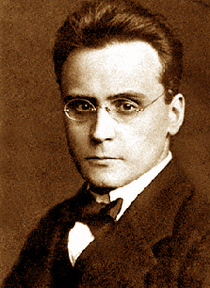

Anton Webern (1883-1945), an Austrian composer and conductor, composed Four Pieces for Violin and Piano, Op. 7 in 1910. When Webern was young, he studied the piano, cello and music theory, and composed in his spare time. He attended the University of Vienna to work towards a doctorate in musicology, and in 1904, as he neared the completion of his degree, he began studying music composition privately with Arnold Schoenberg (1874-1951).
Webern was heavily influenced by Schoenberg, and under Schoenberg's guidance, Webern began to undertake new directions in his compositional technique. Webern favored music which was the opposite of the grandiose, lush sounds of Romanticism. He began composing atonal music which was abstract, highly structured, and extremely concentrated and brief. Webern felt that each individual note of a piece was important, and he used notes sparingly. Music which uses brevity and is extremely concentrated is often called aphoristic, and the term aphoristic is frequently applied to Webern's music. In the 1920s, Webern began composing in the twelve-tone technique (later known as serialism) pioneered by Schoenberg.
During his lifetime, Webern did not achieve much success as a composer because his music was considered too abstract and atonal by the general public. He was forced to support his family through other means such as various conducting positions and teaching. During the 1950s and 1960s, other composers became interested in Webern's compositional style, particularly in features such as his use of brevity and the value of individual notes; his unique interpretation of serialism; and his innovative use of texture, rhythm and dynamics. Webern's musical works included vocal music such as songs, cantatas, a choral work, piano music and chamber music. The instrumentation Webern used was often unconventional such as his Quartet Op. 22 which called for clarinet, saxophone, violin and piano. [15]
TECHNIQUE TIPS: Opus 7 was composed by Anton Webern in 1910, and is entitled Four Pieces for Violin and Piano. Webern used an aphoristic style of composition in this piece, and the music is highly condensed and brief. It is an atonal piece, and Webern utilized an unusual palette of sounds and timbres using various instrumental effects. This arrangement is based on Webern's Op. 7, Piece No. 1, entitled Sehr langsam. Webern's score indicates it should be played very slowly (in German, sehr langsam means "very slowly"), with a mute (mit dämpfer in German). Mutes are small clamps of wood, metal, rubber, leather or plastic, which fit onto the bridge and produce a softer, muted sound with a veiled quality.
This piece begins with an artificial harmonic (also known as a stopped harmonic):
Harmonics are overtones of the string and produce soft, flutelike sounds when the string is lightly touched at specific fractional divisions (nodal points). Natural harmonics are produced on open strings, and artificial or stopped harmonics are produced on stopped strings. Artificial harmonics are produced by firmly pressing the first finger down on a note two octaves below the desired pitch, and then lightly touching the fourth finger a perfect fourth above the notated pitch. This divides the string into fourths, and the resulting sound is two octaves above the stopped pitch. Less commonly used, are artificial harmonics with the finger lightly touching the string a third or fifth above the stopped notes. Webern begins his piece with an artificial harmonic using the first and fourth fingers. To play the first note of the piece, press your first finger down firmly on the D string for the note Eb (a low 1st finger), then lightly touch your fourth finger on the D string for the note Ab (a low fourth finger). This should produce a harmonic two octaves above the stopped note, with a light, silvery sound.
Webern's musical directions also call for col legno beginning in measure 5. Col legno is a term which means the bow should strike the string with the bow stick instead of the bow hair. To do this, turn your bow upside down so the wood of the bow stick is facing the strings, and gently let the stick of your bow bounce on the strings. This should produce a brittle, dry sound. As a side note, some professional string players do not like using their expensive bows to produce this sound, and when this effect is called for in extended passages in orchestral music, they use inexpensive bows. The piece ends with pizzicato (often abbreviated as pizz.), meaning the string should be plucked with the finger instead of being bowed.
© Copyright 2025 RK Deverich. All rights reserved.
Although this online bass class is provided free of charge, all rights are reserved and this content is protected by international copyright law. It is illegal to copy, post or publish this content in any form, and displaying any of this material on other websites, blogs or feeds is prohibited. Permission is given for individual users to print pages and perform music from this website for their personal, noncommercial use.